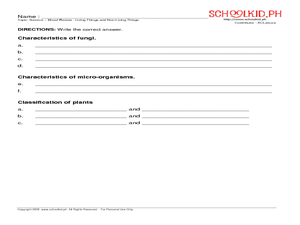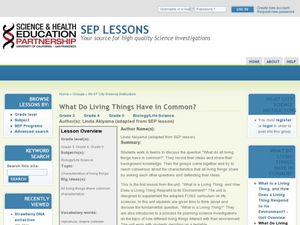Baylor College
Living Things and Their Needs: The Math Link
Enrich your study of living things with these cross-curricular math activities. Following along with the story Tillena Lou's Day in the Sun, learners will practice addition and subtraction, learn how to measure volume and length, work on...
Curated OER
Living Things Worksheet
In this living things practice worksheet, students observe 12 diagrams of both objects and living things. Students must identify the pictures that show living things by crossing out pictures of things that are not living.
Captain Planet Foundation
Sense of Place
Explore the five senses with a kindergarten lesson on gardening. After taking a walk through the class garden, kids note what they see, hear, feel, taste, and smell, and then decide what is living in the garden versus what is not living....
Curated OER
Living and Nonliving Things
Students photograph five objects from a bag and five objects from the outdoors. Students categorize things by living and non-living and by properties such as color, size, structure and needs. Students draw conclusions about the basic...
Curated OER
Living or Non-Living
Students examine living and non-living things. In this life science instructional activity, students are given a group of objects and discuss if they are living or non-living. Students identify and list characteristics of living things.
Curated OER
Terrariums: A Look at the Living and Nonliving World
Third graders examine life in a terrarium and relate it to life in a larger environment. In this terrarium lesson plan, 3rd graders examine how living and non-living things work together by examining the changes in a terrarium. They make...
NASA
Decomposers Get Energy From Dead Things
When life gives you mold, make penicillin. Scholars design an inquiry experiment to determine what causes rotting and mold growth. It also covers decomposers and the important role they play for other living things.
Serendip
Is Yeast Alive?
Through two investigations, life science learners determine whether or not yeast is alive. They perform tests for metabolism by providing sugar and observing if gas is produced as a byproduct. They incubate some of the sample for at...
New South Wales Department of Education
Is it Alive?
Interestingly enough, movement is not a characteristic of living things. The first activity in a series of 20 introduces learners to the concepts of living versus non-living things and then focuses on biologists and what they study....
Curated OER
Living & Non-Living
In this living and non-living organisms worksheet, students read 5 informational signs and decide whether 10 objects or living or non-living and circle their answer underneath each one. Students participate in a scavenger hunt where they...
Curated OER
Science - Mixed Review: Living Things and Non Living Things
In this living and non living things worksheet, students fill in a mixed review that has them answering questions in the true and false, short answer, and classification formats. Students answer 59 questions.
Curated OER
Living and Non Living Things
First graders identify the characteristics of living and non living things. In this living and non living things lesson plan, 1st graders look through bags and categorize items that they see.
Curated OER
Science - What Can Living Things Do
In these living things worksheets, learners write true or false for the sentences about living things. Students answer the questions about living things and choose the words that best describe the statements about living things.
Curated OER
What Do Living Things Have In Common?
Students explore the concept of classification. In this classification lesson, students collaborate to create lists of living thing similarities in order to differentiate between living and non-living things. Students create a list of...
Curated OER
Science - What do living things need?
In this living things worksheet, students answer questions that ask what living things need. Students answer 10 questions in the true and false and short answer format.
Curated OER
Characteristics of Living Things
Students examine the characteristics of living things. They list the differences between living and non-living things, explore areas around the school, and create a Venn diagram for items found in the school areas.
Curated OER
Characteristics of Living Things
Students discuss the criteria for living things with their groups. They come to a consensus on at least five or more characteristics of a living thing. They determine if the lab samples are living, non-living, or other.
Curated OER
Classifying Living Things
Learners identify how to classify living things. They classify various concepts including family members, kinds of clothing, numbers, shapes, and vocabulary words. They discuss how to classify various concepts and classify pictures of...
Curated OER
Basic Needs of Living Things-Lesson One
Fourth graders explore the basic needs of living things. They observe a variety of living things and identify the basic needs of each living item. Students create food balls of peanut butter and nuts to feed animals. They hang their food...
Curated OER
Living things
In this living things worksheet, students color the pictures of living things. Students circle 3 pictures and have 5 to choose from.
Curated OER
Living Things Change and Grow
Students observe how nail polish on a fingernail and petals on a flower grow over time. In this change and grow lesson plan, students observe, discuss, and draw how living things change and grow.
Casimir Middle School
Biological Classification Worksheet
Classify living things with a set of worksheets that has pupils sorting and indentifying living and non-living things. Learners use the worksheets as a basis for finding their answers.
Curated OER
Feed Me!
When youngsters are learning about the basic needs of humans and animals, this instructional activity could come in handy. In it, pupils circle the pictures of a living thing that is eating food. There are eight pictures all in all, and...
Curated OER
Classification of Living Things
Biology learners will be able to explain the binomial nomenclature system and name the seven levels of classification of living things after viewing this set of slides. Brightly colored with bold fonts, the format is eye-catching, and...

























